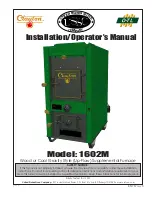
035-15241-003 Rev. A (201)
Unitary Products Group
21
INSTALLATION CHECKS
CHECKING GAS INPUT RATE
The maximum BTUH input capacity for each model is shown
on the furnace rating plate and in the specification table. This
input must not be exceeded.
The input shown may be used in geographic areas where the
elevation is from 0 to 2000 feet. The BTU input depends on
the calorific heating value of the gas, orifice size, and mani-
fold pressure. Orifice sizes are based on gas values of 1050
BTU/cu. ft. for natural gas and 2500 BTU/cu. ft. for LP (pro-
pane) gas. The orifice sizes supplied with the furnace should
provide satisfactory input capacity for installations in most
areas, except at high altitude.
HIGH ALTITUDE ADJUSTMENT
In areas above 2000 feet elevation, the furnace BTU input
must be reduced 4% for each 1000 feet of elevation above
sea level. For minor input adjustments, it is permissible to
adjust the manifold pressure at the gas valve pressure regu-
lator. Do not adjust the manifold pressure more than (.3" W.C.
from the specified regulator settings (3.5" for natural gas and
10" for LP (propane gas). In many cases, adjusting the gas
valve manifold pressure may not be enough to reduce the
gas input enough for high altitudes. In such cases, the gas
orifices must be changed to a smaller size. The chart below
shows the proper gas orifice to use at various altitudes for
either natural or LP (propane) gas.
HOW TO DETERMINE GAS INPUT RATE
Where gas is metered, the input rate may be determined by
the following method:
Contact the gas supplier, Public Utility Company or LP (pro-
pane) gas distributor to obtain the calorific gas value of the
gas being used. When checking the gas input rate, any other
gas burning appliances connected to the same meter should
be completely off. The furnace should be allowed to operate
for five minutes before attempting to check the gas-input rate.
To check flow rate, observe the one cubic foot dial on the gas
meter and determine the number of seconds required for the
dial hand to complete one revolution (seconds to flow one
cubic foot).
To determine the number of seconds per cubic foot that is
necessary to achieve the correct input rate, use the following
formula: GAS VALUE X 3600
÷
DESIRED INPUT = SECONDS NEEDED
Example: 1000 BTU gas, furnace input 100,000 BTUH
Seconds for one cubic foot = 1000 X 3600
÷
100,000 = 36 seconds.
When clocking the meter, if the one cubic foot dial makes a
complete revolution in less time than was calculated that it
should, the furnace is overfired and should be derated. If it
takes more time for the meter to make one revolution than
was calculated, the furnace is underfired.
The orifice size must be changed to correct an overfired or
underfired condition. If it is determined that different orifices
are needed, please contact your distributor for assistance in
selecting the correct replacement.
MINOR INPUT ADJUSTMENT
The input may be adjusted slightly by adjusting the pressure
in the gas valve in order to change manifold pressure.
To adjust pressure regulator, remove cover screw (See loca-
tion on Figure 14) on valve. Turn adjusting screw counter-
clockwise to decrease pressure, turn clockwise to increase
pressure. IN NO CASE SHOULD THE FINAL MANIFOLD
PRESSURE VARY MORE THAN ± .3" W.C. FROM THE
SPECIFIED REGULATOR PRESSURE SETTINGS (3.5"
FOR NATURAL GAS AND 10" FOR LP, PROPANE GAS).
MEASURING AIR TEMPERATURE RISE
For proper furnace operation, the air temperature rise must
be within the range shown on the furnace rating plate.
1.
Place thermometer in the supply air plenum about two
feet from the furnace outlet. If an air conditioning coil is
installed, the thermometer should be placed downstream
of the coil. The thermometer tip should be as near as
possible to the center of the plenum for proper measure-
ment.
FIGURE 15: MANUAL GAS SHUTOFF VALVE
Natural gas heating values can vary widely. It is
the responsibility of the installer to make sure that
the input rate to the furnace as installed does not
exceed the nameplate rating of the furnace. Fail-
ure to do so can cause heat exchanger failure, re-
sulting in injury or death.
High Altitude Gas Orifices
Altitude above sea level in feet
0-
2000
2000-
4500
4500-
8000
8000-
9000
9000-
10,000
Natural
Gas
#42
.093
#43
.089
#44
.086
#45
.082
#46
.081
LP Gas
#54
.055
#55
.052
#55
.052
#56
.046
#56
.046
OFF
ON
OFF
ON
Operating the furnace outside of the proper air
temperature rise range may cause poor heating
performance and shorter heat exchanger life.




































